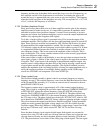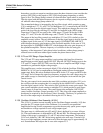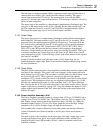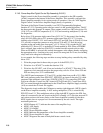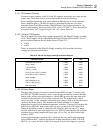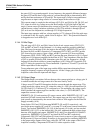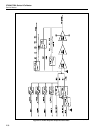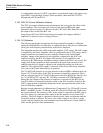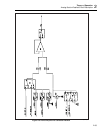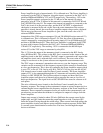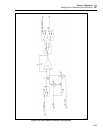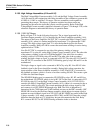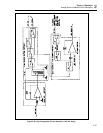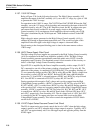
Theory of Operation
Analog Section Detailed Circuit Description
2
2-91
2-149. PA Operation: 220V AC Range
During ac operation, Power Amplifier gain is -10 as determined by the 4.99 kΩ input
resistor R17, and 49.9 kΩ feedback resistors (R11 + R12 + R13). Control line SW3 turns
Q50 on, which references the +input of the precision op amp in the input stage to OS
COM. The Oscillator assembly (A13) is set to the 22V range and its output OSC OUT
HI is connected to the input resistor R17 by relay K10A. The Power Amplifier output is
connected to the feedback resistors R11-R13 by relay K12B.
The Power Amplifier output is attenuated by a precise 1/100 by 220V range ac
attenuator. The attenuated signal is connected to OSC SENSE HI, where it is sent to the
Oscillator Control assembly (A12). The Oscillator Control assembly regulates the
Oscillator Output so that an exact calibrated ac signal appears at OSC SENSE HI. Since
the 220V range ac attenuator is completely characterized (as explained below), the exact
desired signal appears at PA SENSE AC and hence at the appropriate sense point at the
output.
The 220V range ac attenuator circuit contains op amp U4, a 400 kΩ/4 kΩ resistor
network Z1, and transistor Q54. PA SENSE AC, which is connected to PA OUT HI at
the load, is connected to the 400 kΩ input resistor (pin 1) of Z1 by relay K16. The 400
kΩ/4 kΩ node (pin 3) of Z1 is connected to the inverting input of U4.
During ac operation, control line C0* is inverted by U8, which turns on Q58 to connect
the non-inverting input to OSC RCOM. Transistor Q54 supplies current gain for the
output of U4 to drive the capacitance of the OSC SENSE HI line. This voltage is
connected to the 4 kΩ feedback resistor (pin 4) of Z1. The output is connected to OSC
SENSE HI by relays K10B and K11. The dc feedback 500 kΩ/25 kΩ resistor network
and the sense-current cancellation circuitry are disconnected by energizing K15.
The sense signal, PA SENSE AC, and the output signal, PA OUT HI, are routed to the
High Voltage Control assembly (A14), where relays K10, K13, and K3 connect them to
HV SENSE and HV OUT. HV SENSE and HV OUT are connected to the binding posts
by the motherboard relays in the same manner as in the 1100V high voltage mode. Refer
to the High Voltage assembly theory of operation for more information.
2-150. High Voltage Assembly Support Mode
2-151. High Voltage AC 1100V Range
During high voltage ac operation, the output of the Power Amplifier is routed to the
input of a step up/down transformer on the High Voltage Control assembly (A14).
Overall gain from the Oscillator Output to the High Voltage Output is -100 as
determined by the 4.99 kΩ input resistor R17, and 500 kΩ feedback resistor (R3 + R4 +
R81 + R82 + R83). Relay K10A connects the ac signal OSC OUT HI from the Oscillator
Output assembly to input resistor R17. Relay K12 remains open as shown on the
schematic, while K15 is energized to remove feedback used in 220V-dc operation.
Output from the High Voltage Control assembly, called HVAC on the schematic, is
connected to the feedback resistors. Relay K17B is energized to close the feedback loop.
Control line SW3 is high, which turns Q50 on and turns Q51 off. Because sensing back
to the Oscillator Control assembly is done by the High Voltage/High Current assembly,
the output of the 220V range ac attenuator is disabled from OSC SENSE HI by relay
K11.
2-152. High Voltage DC 1100V Range and Current 2.2A Range
Operation of the Power Amplifier is the same for the 1100V dc and the 2.2A current
functions. In these functions, the output of the Power Amplifier is routed to a step
up/down transformer on the High Voltage Control assembly (A14). The Power Amplifier



